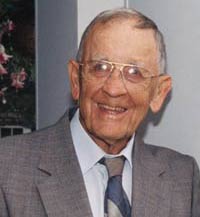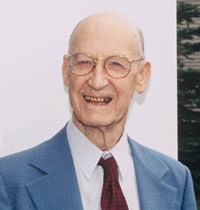Bob and Gerald, the Cleveland Brothers, spent over 75 years of their lives with type 1 diabetes.
Bob Cleveland
In the early 20th century, diabetes was the “disease that nobody talked about.” Insulin had just been discovered, but there was no way of monitoring blood glucose levels, making type 1 diabetes an unpredictable and often deadly disease.
Bob Cleveland saw the damage it could do first hand, when the principal of his grammar school lost a leg to diabetes. Bob himself had been diagnosed in 1925, at the age of five, and he spent his whole life battling against the ignorant perceptions and lack of care associated with the condition. On this front, he proved the whole world wrong, living to the ripe old age of 89.
He recalls not being optimistic about his diagnosis. In fact, he “thought [he] was going to the hospital to die.” In most cases, this wouldn’t be far wrong; the lack of any means of blood glucose testing made diabetes management a nearly impossible task.
The early years were difficult. Bob remembers his mother pulling him out of diabetic comas. She used to test his urine to find out if there was sugar in it. He remembers her great efforts to support his diabetes management:
“The doctor prescribed the diet I should be on, and my mother was most careful about sticking to it. There were very few carbohydrates, a quart and a half of milk every day, and there were lots of vegetables and proteins. She weighed everything I ate on a scale. I could have 20 grams of bread at breakfast, which meant I couldn’t have a complete slice.
“I remember my mother sharpening the needle each time on a whetstone, but sometimes it was like getting stuck with a knitting needle.”
Bob and his mother quickly deduced the benefits of exercise for people with diabetes. When he had been physically active, Mrs. Cleveland would cut back on his insulin dose. It wasn’t an exact science, but as a scientific observation it was way ahead of its time.
Bob’s commitment to physical activity continued throughout his life. He was an avid cyclist, often riding twenty miles or more at a time. He said that during a particularly long ride he could go all day without a single bolus injection; the exercise did all the work for him.
On the whole, Bob’s diabetes was well-controlled, but that didn’t change the negative perceptions of diabetes that were rife at the time. Potential employers didn’t like it. Despite having a degree in accounting, Bob was rejected for several jobs after they learned of his condition.
So Bob didn’t mention it. And as soon as he starting keeping it quiet, he was offered a job as an accountant with General Motors in Syracuse, New York. His career was long and successful, with Bob ending up as the supervisor of General Motor’s general accounting section for a number of years. Diabetes never held him back, but the ignorant assumptions made by potential employers did.
Bob passed away in 2010, at the age of 89. He credited his longevity to his exercise, careful diet, rigorous blood sugar monitoring (once it became available), and the support of his wife of over 60 years, Ruth.
Gerald Cleveland
Bob had a brother, Gerald. And, like Bob, Gerald had type 1 diabetes. Remarkably, Gerald lived even longer, dying in 2009 at the age of 93.
Gerald, despite being older, was the second of the brothers to have diabetes. Like Bob, he showed an inspiring commitment to good diabetes management. One of his first diabetes doctors gave him a menu of foods that he could eat if he wanted to keep his blood sugars low. That menu, no doubt dog-eared and dilapidated, remained posted on his kitchen door until his death.
He had a successful career in education: starting out as a teacher, Gerald then became a principal, and then became assistant superintendent for the Syracuse School District. On top of his career achievements, Gerald helped to found the public television station in Syracuse, and was involved with Rescue Mission for almost 60 years.
Gerald was a valued and much-loved member of his community, a life-long resident of Syracuse who made an indelible positive impact on everyone around him. He was very active with the East Genesee Presbyterian Church and First Presbyterian Church United.
In total, he lived with type 1 diabetes for over 75 years. And, like his brother, he could rely on the constant support of his spouse, Mildred. They were married for 62 years, and in that time she never swayed in her watchful vigil over her husband’s diabetes. Even while she was dying, she would make sure that her husband wasn’t enduring the overnight sweating that would suggest nocturnal hypogylcemia. Gerald recalls:
“One time when she had basically been bedridden for weeks, she found the strength to get up and go to the kitchen, and poured orange juice and brought it back and made me drink it.”
In total, Gerald had type 1 diabetes for 75 years. And although he took diabetes management incredibly seriously, it wasn’t easy. Both Gerald and his brother had a few scares. Gerald nearly died following an infection, but doctors sorted him out with the newly-discovered penicillin. Shortly before his death, his blood sugars were so low that he became dizzy and fell. The injury required five stitches. Both brothers have developed some form of diabetic neuropathy, which has required the amputation of toes. On top of all that, Gerald suffers from a rare condition, the likelihood of which is increased by diabetes, that makes the hands ball up into fists involuntarily.
Gerald has a daughter named Linda, a son-in-law, five grandchildren, and six great-grandchildren.
“It hasn’t been easy,” Gerald says, “but I’ve had a wonderful life.”
Both Cleveland brothers have been honoured for their longevity with type 1 diabetes and the strength of their characters. The Lilly Pharmaceutical Company erected a monument to them in Indianapolis.
Dr. George L. King, research director of the Joslin Diabetes in Boston, recalls their proactive attitude to diabetes management fondly:
“They’re a little bit obsessive about their records and their diets,” he said. Dr. King also explained how they would arrive carrying “years and years of records, sometimes decades. They are more careful about their health than even most diabetics, and they also have a very positive outlook.”
Gerald, however, isn’t particularly comfortable with his status as a “diabetes legend”: “I feel like a very ordinary guy, but then there’s this other person that everyone looks up to that hardly feels like me – the one who’s an inspiration to so many people living with diabetes. I’m just afraid of letting them down somehow.” In 75 years of living with diabetes, he never did.
Image sources: nytimes.com; diabeteshealth.com
Information adapted from diabeteshealth.com, shericolberg.com, nytimes.com, obitsforlife.com, diabetesforecast.org, and legacy.com.





